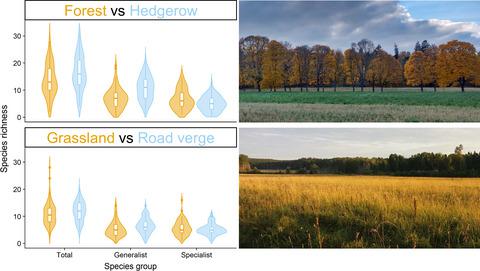当前位置:
X-MOL 学术
›
J. Appl. Ecol.
›
论文详情
Our official English website, www.x-mol.net, welcomes your feedback! (Note: you will need to create a separate account there.)
Plant diversity in hedgerows and road verges across Europe
Journal of Applied Ecology ( IF 5.7 ) Pub Date : 2020-04-13 , DOI: 10.1111/1365-2664.13620 Thomas Vanneste 1 , Sanne Govaert 1 , Willem De Kesel 1 , Sanne Van Den Berge 1 , Pieter Vangansbeke 1 , Camille Meeussen 1 , Jörg Brunet 2 , Sara A. O. Cousins 3 , Guillaume Decocq 4 , Martin Diekmann 5 , Bente J. Graae 6 , Per‐Ola Hedwall 2 , Thilo Heinken 7 , Kenny Helsen 8 , Rozália E. Kapás 3, 6 , Jonathan Lenoir 4 , Jaan Liira 9 , Sigrid Lindmo 6 , Kathrin Litza 5 , Tobias Naaf 10 , Anna Orczewska 11 , Jan Plue 3 , Monika Wulf 9 , Kris Verheyen 1 , Pieter De Frenne 1
Journal of Applied Ecology ( IF 5.7 ) Pub Date : 2020-04-13 , DOI: 10.1111/1365-2664.13620 Thomas Vanneste 1 , Sanne Govaert 1 , Willem De Kesel 1 , Sanne Van Den Berge 1 , Pieter Vangansbeke 1 , Camille Meeussen 1 , Jörg Brunet 2 , Sara A. O. Cousins 3 , Guillaume Decocq 4 , Martin Diekmann 5 , Bente J. Graae 6 , Per‐Ola Hedwall 2 , Thilo Heinken 7 , Kenny Helsen 8 , Rozália E. Kapás 3, 6 , Jonathan Lenoir 4 , Jaan Liira 9 , Sigrid Lindmo 6 , Kathrin Litza 5 , Tobias Naaf 10 , Anna Orczewska 11 , Jan Plue 3 , Monika Wulf 9 , Kris Verheyen 1 , Pieter De Frenne 1
Affiliation

|
Linear landscape elements such as hedgerows and road verges have the potential to mitigate the adverse effects of habitat fragmentation and climate change on species, for instance, by serving as a refuge habitat or by improving functional connectivity across the landscape. However, so far this hypothesis has not been evaluated at large spatial scales, preventing us from making generalized conclusions about their efficacy and implementation in conservation policies. Here, we assessed plant diversity patterns in 336 vegetation plots distributed along hedgerows and road verges, spanning a macro‐environmental gradient across temperate Europe. We compared herb‐layer species richness and composition in these linear elements with the respective seed‐source (core) habitats, that is, semi‐natural forests and grasslands. Next, we assessed how these differences related to several environmental drivers acting either locally, at the landscape level or along the studied macro‐ecological gradient. Across all regions, about 55% of the plant species were shared between forests and hedgerows, and 52% between grasslands and road verges. Habitat‐specialist richness was 11% lower in the linear habitats than in the core habitats, while generalist richness was 14% higher. The difference in floristic composition between both habitat types was mainly due to species turnover, and not nestedness. Most notably, forest‐specialist richness in hedgerows responded positively to tree cover, tree height and the proportion of forests in the surrounding landscape, while generalist richness was negatively affected by tree height and buffering effect of trees on subcanopy temperatures. Grassland and road verge diversity was mainly influenced by soil properties, with positive effects of basic cation levels on the number of specialists and those of bioavailable soil phosphorus on generalist diversity. Synthesis and applications. We demonstrate that linear landscape elements provide a potential habitat for plant species across Europe, including slow‐colonizing specialists. Additionally, our results stress the possibility for land managers to modify local habitat features (e.g. canopy structure, subcanopy microclimate, soil properties, mowing regime) through management practices to enhance the colonization success of specialists in these linear habitats. These findings underpin the management needed to better conserving the biodiversity of agricultural landscapes across broad geographical scales.
中文翻译:

欧洲绿篱和道路边缘的植物多样性
树篱和道路边缘等线性景观元素有可能减轻栖息地破碎化和气候变化对物种的不利影响,例如,作为避难栖息地或改善整个景观的功能连通性。然而,到目前为止,这一假设尚未在大空间尺度上进行评估,这使我们无法对其在保护政策中的有效性和实施情况做出概括性结论。在这里,我们评估了沿绿篱和道路边缘分布的 336 个植被地块中的植物多样性模式,跨越了整个欧洲温带的宏观环境梯度。我们将这些线性元素中的草本层物种丰富度和组成与各自的种子源(核心)栖息地,即半天然森林和草原进行了比较。下一个,我们评估了这些差异如何与在局部、景观水平或沿研究的宏观生态梯度起作用的几种环境驱动因素相关。在所有地区,大约 55% 的植物物种在森林和树篱之间共享,52% 在草地和道路边缘之间共享。线性栖息地的栖息地专家丰富度比核心栖息地低 11%,而通才丰富度高 14%。两种栖息地类型之间植物区系组成的差异主要是由于物种更替,而不是嵌套。最值得注意的是,树篱中的森林专家丰富度对树木覆盖率、树木高度和周围景观中的森林比例有积极的反应,而一般丰富度则受到树木高度和树木对冠层温度的缓冲作用的负面影响。草地和道路边缘多样性主要受土壤性质的影响,基本阳离子水平对专家数量的积极影响和生物可利用土壤磷对一般多样性的积极影响。合成与应用。我们证明了线性景观元素为整个欧洲的植物物种提供了潜在的栖息地,包括缓慢殖民的专家。此外,我们的结果强调了土地管理者通过管理实践来改变当地栖息地特征(例如冠层结构、冠层小气候、土壤特性、割草制度)的可能性,以提高专家在这些线性栖息地的殖民成功率。这些发现支持了在广泛的地理范围内更好地保护农业景观生物多样性所需的管理。
更新日期:2020-04-13
中文翻译:

欧洲绿篱和道路边缘的植物多样性
树篱和道路边缘等线性景观元素有可能减轻栖息地破碎化和气候变化对物种的不利影响,例如,作为避难栖息地或改善整个景观的功能连通性。然而,到目前为止,这一假设尚未在大空间尺度上进行评估,这使我们无法对其在保护政策中的有效性和实施情况做出概括性结论。在这里,我们评估了沿绿篱和道路边缘分布的 336 个植被地块中的植物多样性模式,跨越了整个欧洲温带的宏观环境梯度。我们将这些线性元素中的草本层物种丰富度和组成与各自的种子源(核心)栖息地,即半天然森林和草原进行了比较。下一个,我们评估了这些差异如何与在局部、景观水平或沿研究的宏观生态梯度起作用的几种环境驱动因素相关。在所有地区,大约 55% 的植物物种在森林和树篱之间共享,52% 在草地和道路边缘之间共享。线性栖息地的栖息地专家丰富度比核心栖息地低 11%,而通才丰富度高 14%。两种栖息地类型之间植物区系组成的差异主要是由于物种更替,而不是嵌套。最值得注意的是,树篱中的森林专家丰富度对树木覆盖率、树木高度和周围景观中的森林比例有积极的反应,而一般丰富度则受到树木高度和树木对冠层温度的缓冲作用的负面影响。草地和道路边缘多样性主要受土壤性质的影响,基本阳离子水平对专家数量的积极影响和生物可利用土壤磷对一般多样性的积极影响。合成与应用。我们证明了线性景观元素为整个欧洲的植物物种提供了潜在的栖息地,包括缓慢殖民的专家。此外,我们的结果强调了土地管理者通过管理实践来改变当地栖息地特征(例如冠层结构、冠层小气候、土壤特性、割草制度)的可能性,以提高专家在这些线性栖息地的殖民成功率。这些发现支持了在广泛的地理范围内更好地保护农业景观生物多样性所需的管理。


























 京公网安备 11010802027423号
京公网安备 11010802027423号